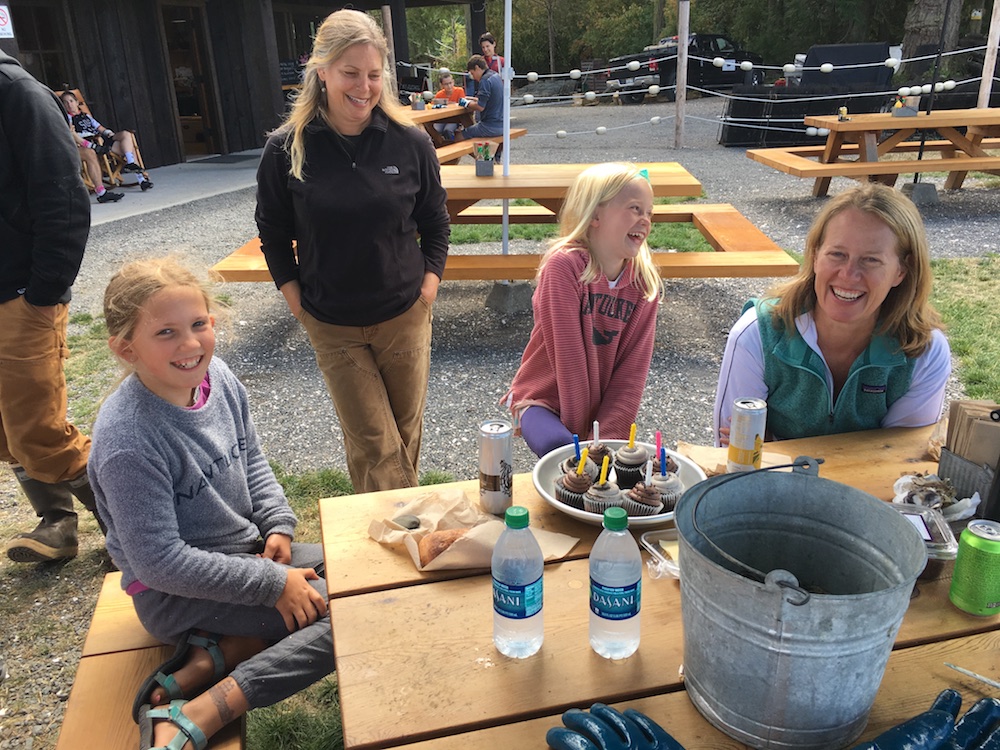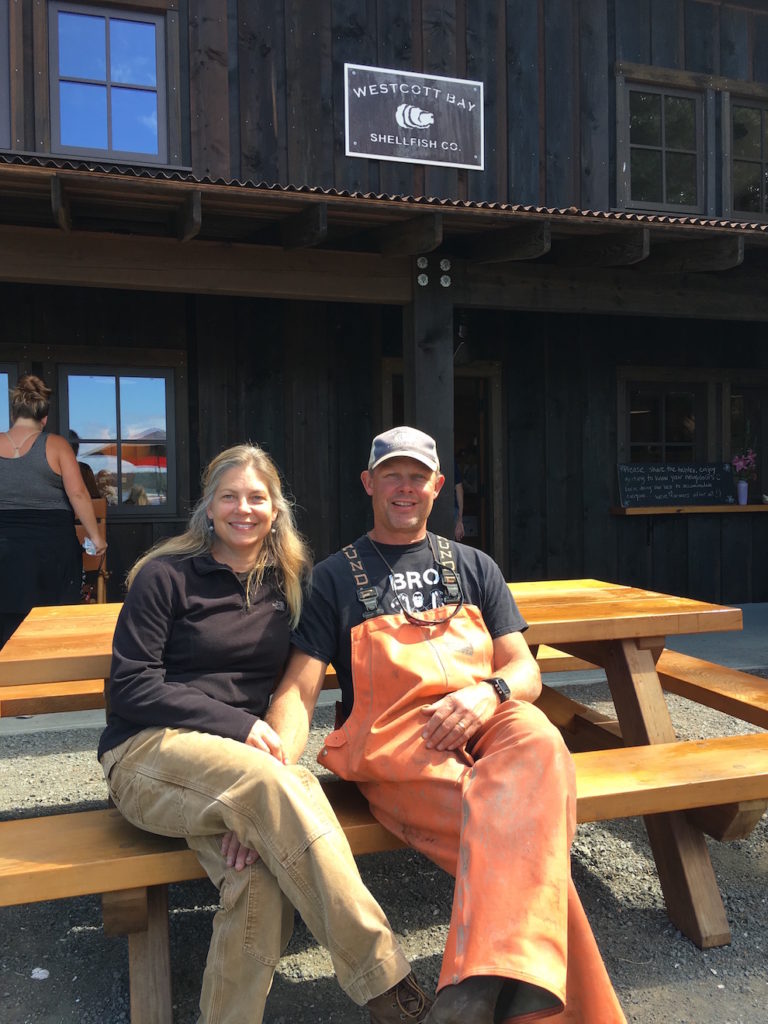
Tenth birthday at Westcott Bay Shellfish Farm (birthday girl in center) | Photo: SJPT Staff
Off the Map
Oysters are not my thing. But when my daughter announced that she wanted to celebrate her tenth birthday with family and friends at Westcott Bay Shellfish farm, I couldn’t suppress a proud smile.
The San Juan Preservation Trust has accomplished much in its 38 years, and the most recent statistics confirm that we are one of the most prolific land trusts in the country. Among 1,360 land trusts, only 28 others have protected more properties than we have. But the story of my daughter’s chosen birthday venue is an example of the type of community work the Preservation Trust is doing that will never be captured in these statistics.
READ MORE …
This story begins in the mid-1960s, when Bill and Doree Webb purchased a 75-acre property on San Juan Island’s Westcott Bay and, through decades of innovation and hard work, established a thriving little oyster farm near the mouth of a freshwater stream. Shellfish production is a challenging and labor-intensive business. Despite producing exceptionally high-quality oysters prized by restaurants around the country, by 2005 or so the family had reached a point of fatigue.
After a failed effort to raise funds for the business by selling a conservation easement to the San Juan County Land Bank, the family decided to list their estate for sale in 2010. While they held out hope that a buyer might maintain the shellfish farm, it was evident that their property—which included almost one-half mile of shoreline, a perennial stream, old-growth forest, and a rare deep-water dock—would more likely attract a buyer interested in its potential as a residential development. As the property hit the market with a price of $6.2 million, a prominent Seattle restaurateur— a loyal purveyor of Westcott Bay oysters—showed me a copy of a letter he had received announcing that the shellfish business was shutting down. “These oysters are too good to lose,” he said to me. “What can we do to save them?”
Once part of the historic English army encampment, the Webb’s land was adjacent to what is now the National Park Service’s “English Camp.” Soon after learning of the sale listing, I received a call from Peter Dederich, superintendent of the National Historical Park. Peter had a dream to reintegrate the Webb property back into English Camp, and explained that the Park Service had, for a limited amount of time, fortuitous access to Congressionally appropriated capital funds that could be used to acquire additional land. Peter understood that the oyster farm was an important cultural and economic resource, but he made it clear that his superiors at the National Park Service (who were still smarting from a recent battle they’d had with oyster farmers in California) had no appetite for championing a shellfish operation.
Peter asked the Preservation Trust to step in to help Park Service bridge the financial and timing gaps that were impeding their ability to acquire the land. Working with the staff of the San Juan County Land Bank, who had remained interested in seeing the Webb property protected, we entered into a long and tortuous negotiation to bring the Park Service and the Webb family to some sort of agreement.
A plan started to bubble up. We would first carve off the shellfish farm, including five acres, the dock and the dilapidated retail and processing structures, and then search for a shellfish producer willing to take over operation of the farm. At the same time, The Conservation Fund (TCF), a national nonprofit with considerable experience bridging the timing gaps often associated with federal appropriations, was brought in to help. As this partnership of two nonprofits (the Preservation Trust and TCF) and two government agencies (National Park Service and the Land Bank) set out to purchase and hold the remaining 70 acres for eventual conveyance into English Camp, the Preservation Trust turned its attention to the shellfish farm.
The community had a strong interest in keeping the oyster farm alive. Not only had it contributed jobs and diversity to our economy, but it had also become an important cultural institution for both residents and tourists. Recognizing this the Preservation Trust set out on its own to find a shellfish producer willing to take over the five-acre operation. We called on dozens of producers along the west coast, and even offered to lease the shellfish farm for free in exchange for a commitment to invest at least $1 million in the operation.
Calling upon the experience and storytelling expertise of Frank Raue, who had worked on the shellfish farm for many years, we hosted several trips from interested producers. These visitors included two brothers who own the largest shellfish producer in our region (“Wow. That is a really good oyster,” confided one brother to the other after prying open a plump, milky, boot-sized spawning oyster they’d picked up on the beach). While these experts all agreed that the quality of the shellfish was truly exceptional, the farm’s remote location and small size triggered significant concerns about production capacity and distribution. It simply didn’t pencil out.
The sale of the remaining 70 acres to the National Park Service was contingent on finding a separate buyer for the sea farm property. Our inability to entice an established producer to take over the shellfish business had led us to a crushing realization: If we wanted to see the majority of the property protected in the National Historical Park, we would have to redirect our search to buyers interested in converting the oyster farm into a residential estate.
Enter the Andersons.
Erik Anderson spent much of his childhood exploring the islands from his family’s home base on Henry Island. He met Andrea, a California girl, at the University of Washington, and soon thereafter introduced her to life in the San Juan Islands. Among their traditions were frequent visits to the Westcott Bay shellfish farm, where they gathered up oysters and left cash behind in the Webb’s honor system jar. Their careers eventually took them around the world before they settled in Connecticut, but they maintained a strong connection to the islands. With their retirement in view, they purchased land on Henry Island and began to build a home where they could enjoy their next phase living in the place they loved most.
The Andersons were keenly aware that the shellfish farm was under threat, and they would check in periodically to see if the producers we were courting had shown any interest. Sensing our frustration, and recognizing that this iconic treasure could soon be lost, they made a decision in 2013 that surprised us all: With no shellfish production, distribution or marketing experience whatsoever, they offered to purchase the sea farm, retain its employees, and invest heavily in its infrastructure.
With the Andersons on board, the rest of our plan fell nicely—if not easily—into place. English Camp has recaptured a large chunk of its original land base, and Westcott Bay Shellfish Company has once again become, in a relatively short time, one of San Juan Island’s most important community assets.
The San Juan Preservation Trust put more than three years into this effort, which included countless staff hours, difficult negotiations, apprehensive sellers, a recalcitrant real estate agent, an untested partnership, and a federal agency bound by rules and beholden to an unpredictable Congress. But as the Preservation Trust ended up without any ownership interest in either English Camp or Westcott Bay Shellfish Company, neither of these properties will ever appear on our map of protected properties, nor will they help to elevate our national ranking.
And who cares. Westcott Bay Shellfish Company continues to add new jobs to our local economy, and it is once again a vibrant attraction for locals and tourists alike—a place where residents and visitors choose to come together to enjoy the bounty of our islands. On any given summer day, you can find locals and tourists sitting together at the same large picnic table, slurping shellfish, sharing stories, and laughing at each other as they learn how to shuck an oyster. As my daughter prepares for her 10th birthday party at her favorite gathering place, I’m proud to work for a conservation organization that encourages creativity, patience and partnerships, and that recognizes diverse community values in its outcomes.
But I still don’t like oysters.

Andrea and Erik Anderson at their sea farm | Photo: SJPT Staff
